Abstract
Experience in the management of mass casualties following a disaster is relatively sparse. The terrorist bombing serves as a timely and effective model for the analysis of patterns of injury and mortality and the determination of the factors influencing casualty survival in the wake of certain forms of disaster. For this purpose, a review of the published experience with terrorist bombings was carried out, providing a study population of 3357 casualties from 220 incidents worldwide. There were 2934 immediate survivors of these incidents (87%), of whom 881 (30%) were hospitalized. Forty deaths ultimately occurred among these survivors (1.4%), 39 of whom were among those hospitalized (4.4%). Injury severity was determined from available data for 1339 surviving casualties, 251 of whom were critically injured (18.7%). Of this population evaluable for injury severity, there were 31 late deaths, all of which occurred among those critically injured, accounting for an overall "critical mortality" rate of 12.4%. Overall triage efficiency was characterized by a mean overtriage rate (noncritically injured among those hospitalized or evacuated) of 59%, and a mean undertriage rate (critically injured among those not hospitalized or evacuated) of .05%. Multiple linear regression analysis of all major bombing incidents demonstrated a direct linear relationship between overtriage and critical mortality (r2 = .845), and an inversely proportional relationship between triage discrimination and critical mortality (r2 = 0.855). Although head injuries predominated in both immediate (71%) and late (52%) fatalities, injury to the abdomen carried the highest specific mortality rate (19%) of any single body system injury among immediate survivors. These data clearly document the importance of accurate triage as a survival determinant for critically injured casualties of these disasters. Furthermore, the data suggest that explosive force, time interval from injury to treatment, and anatomic site of injury are all factors that correlated with the ultimate outcome of terrorist bombing victims. Critical analysis of past disasters should allow for sufficient preparation so as to minimize casualty mortality in the future.
Full text
PDF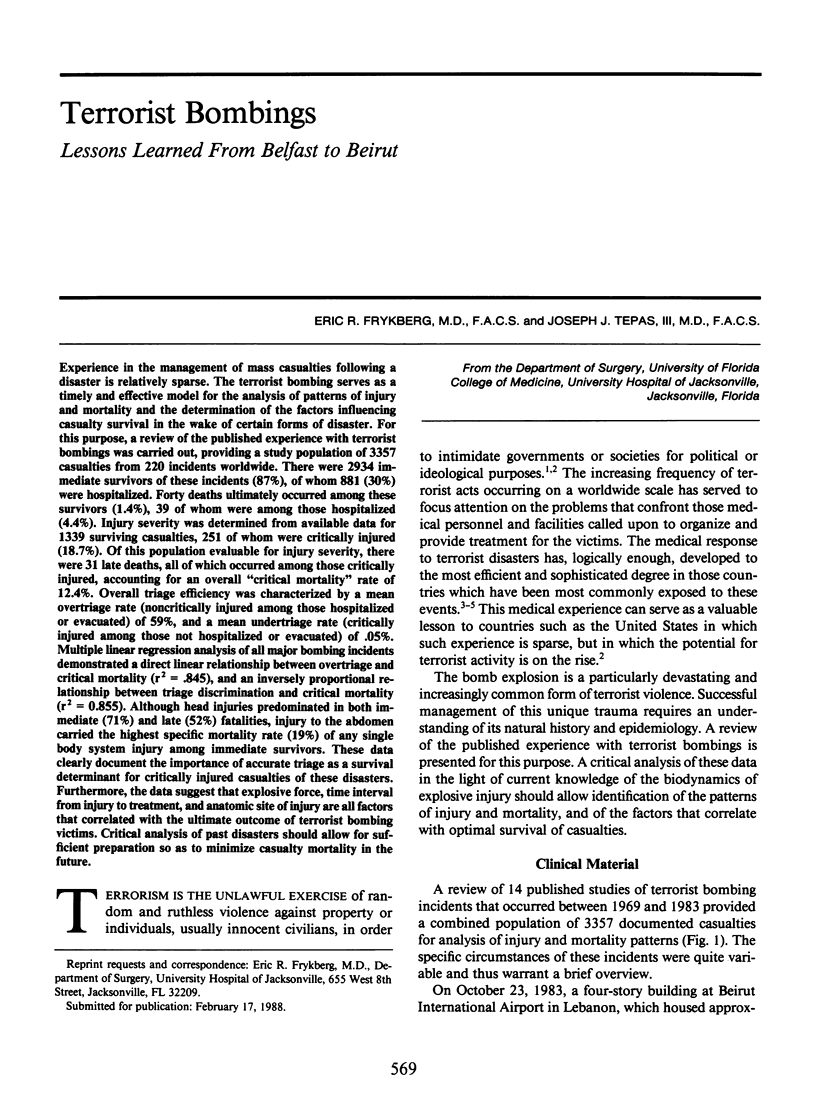
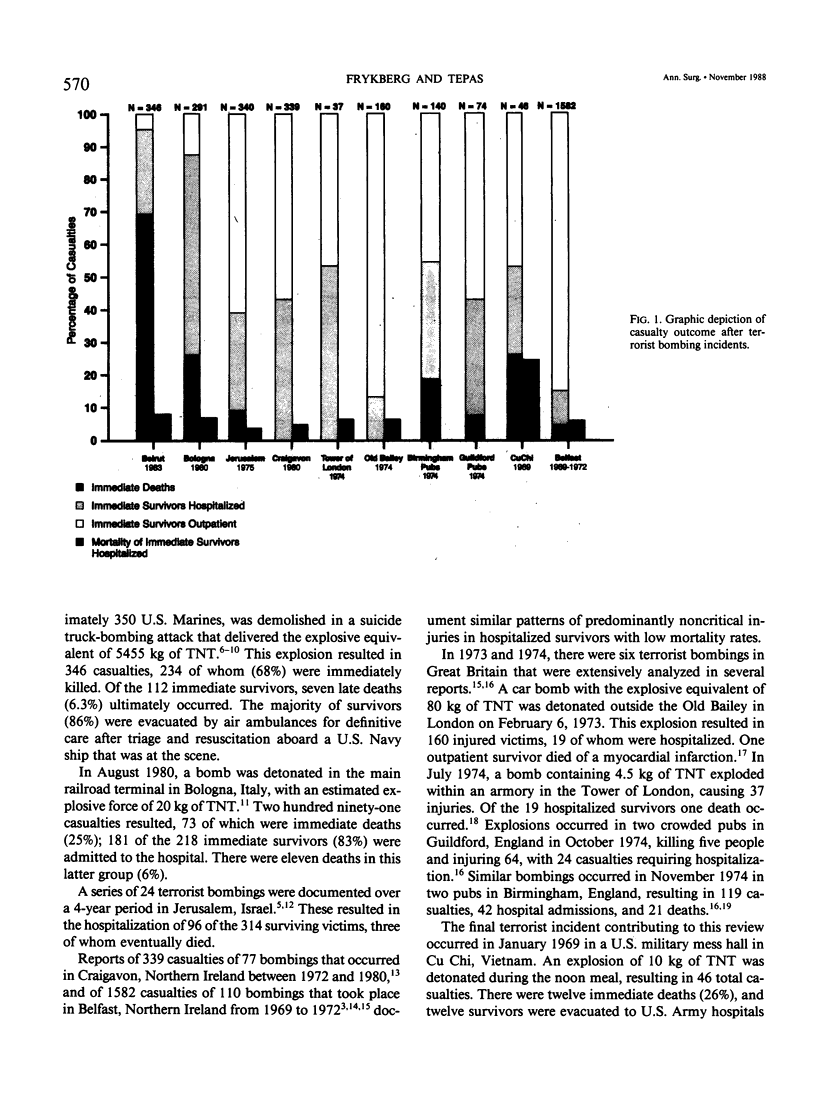
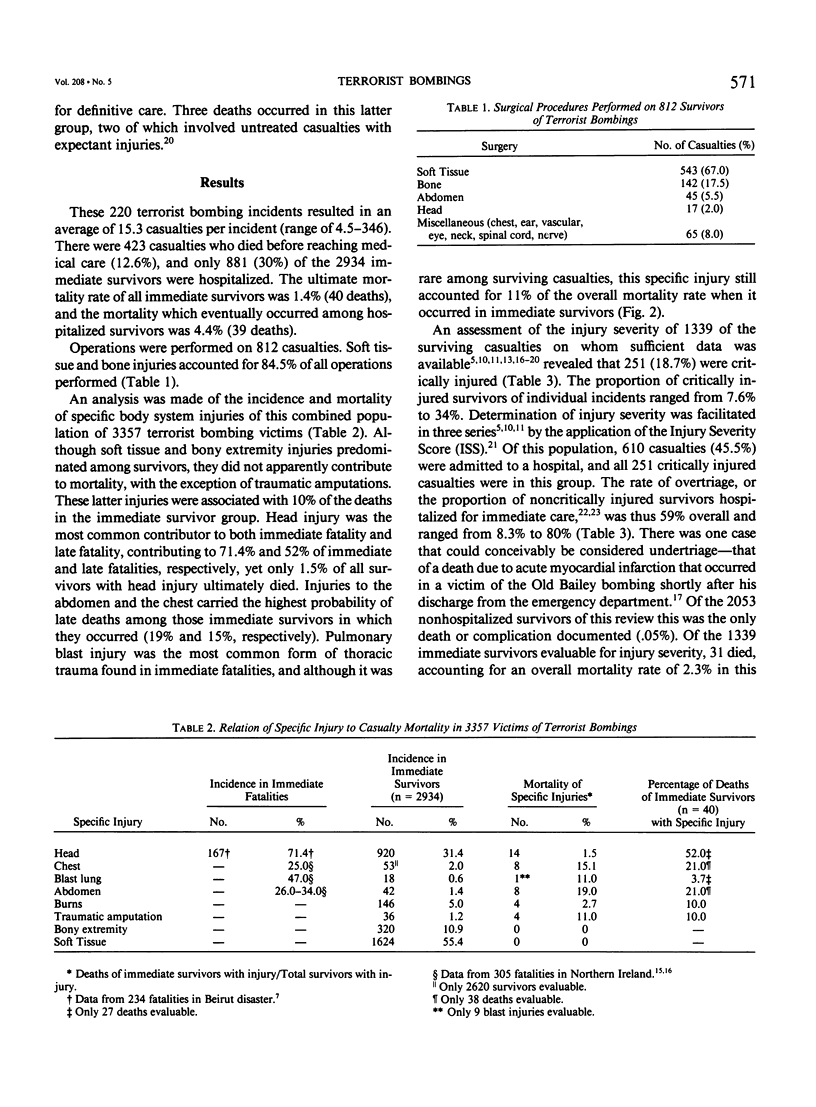
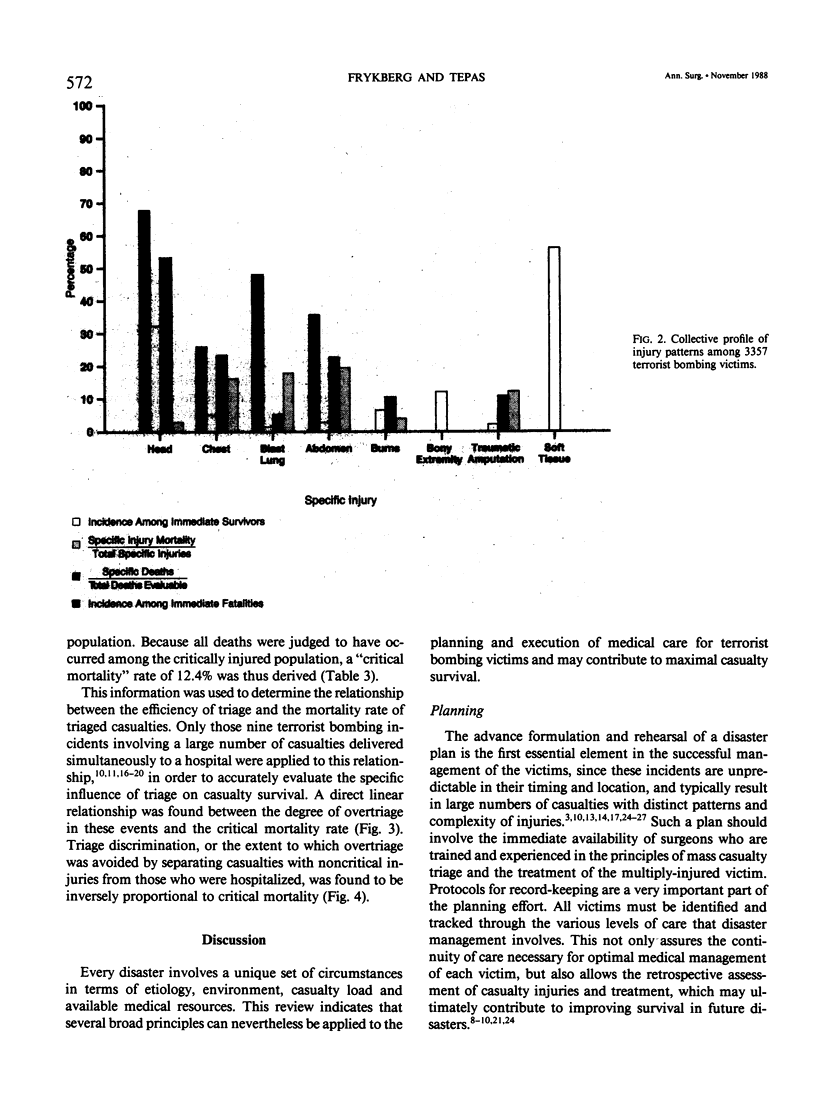
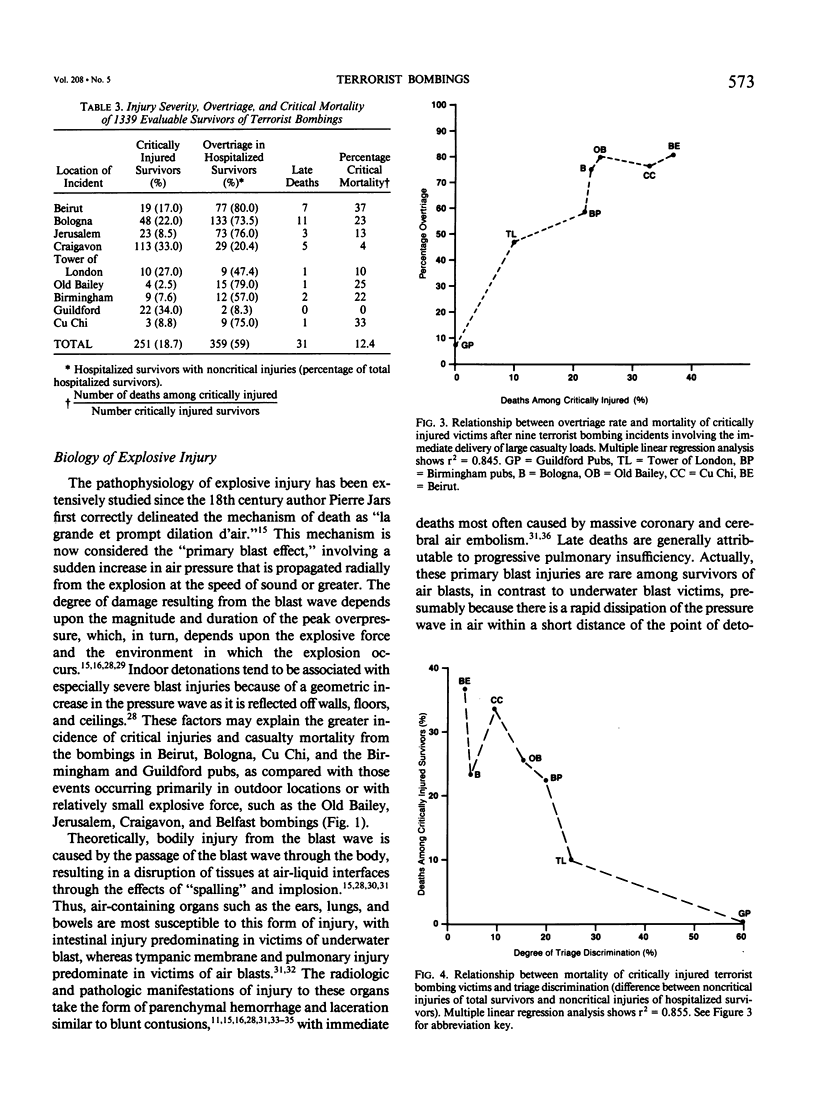
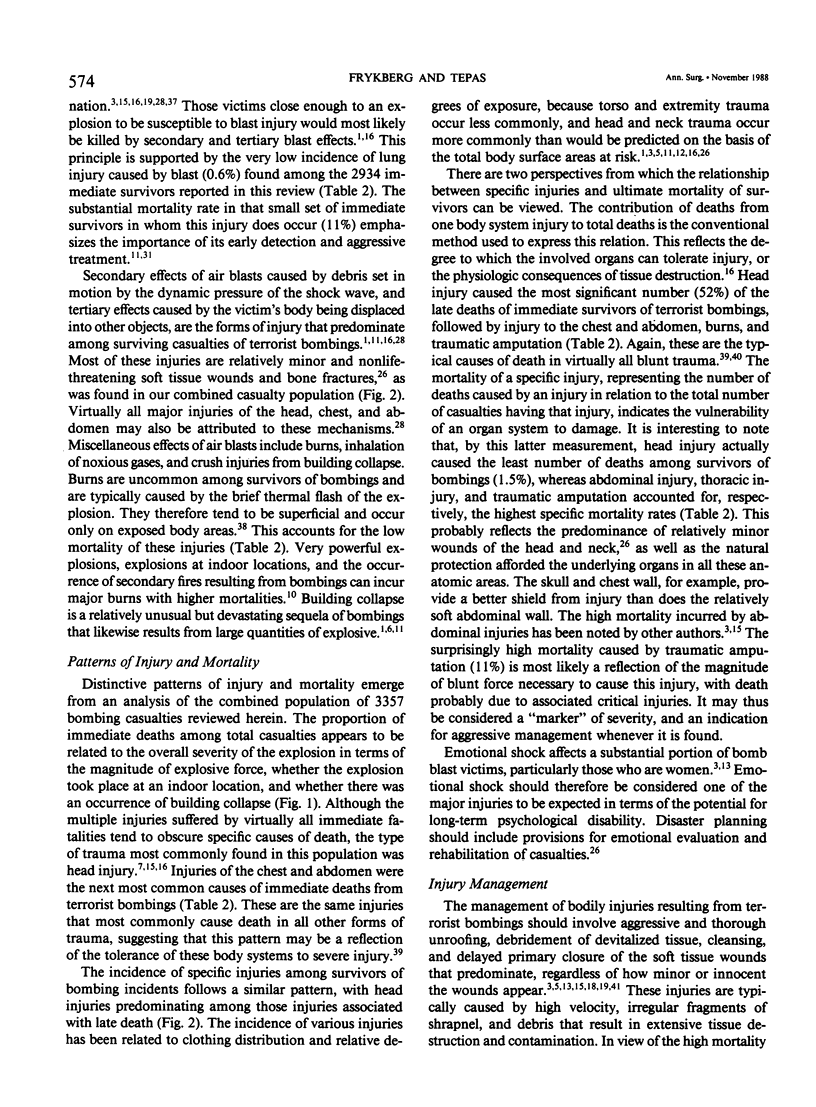
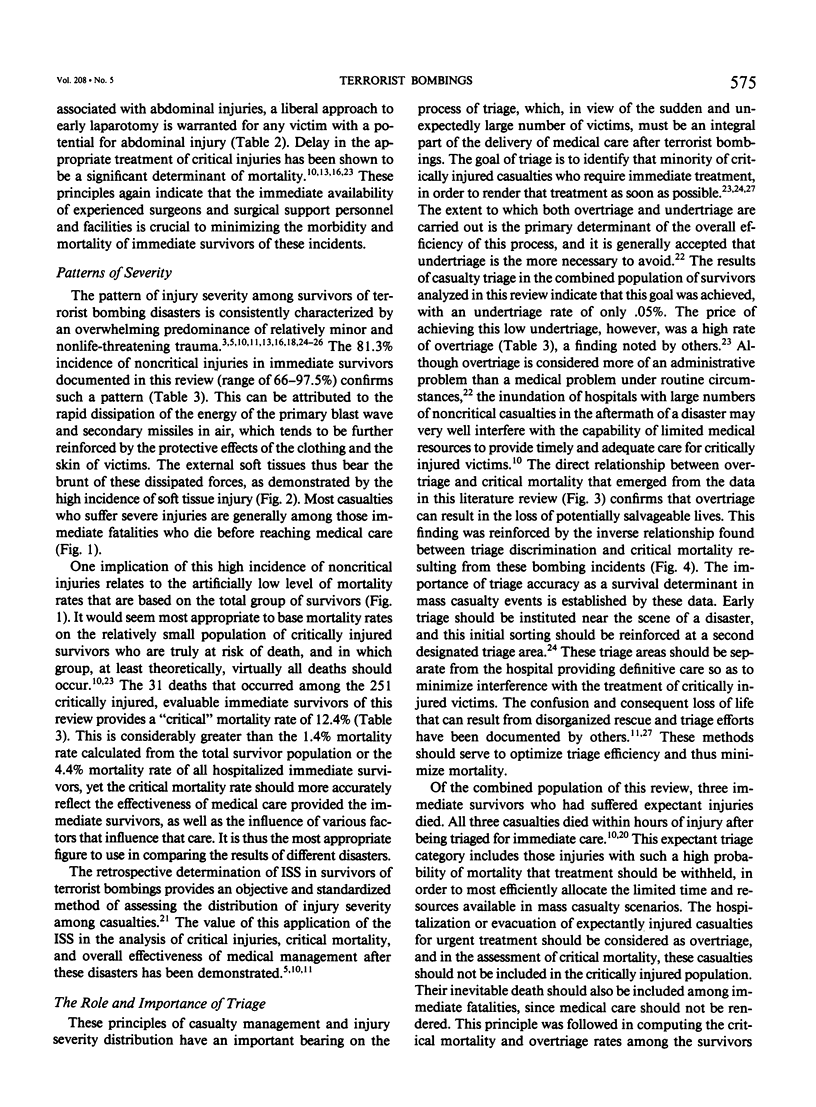
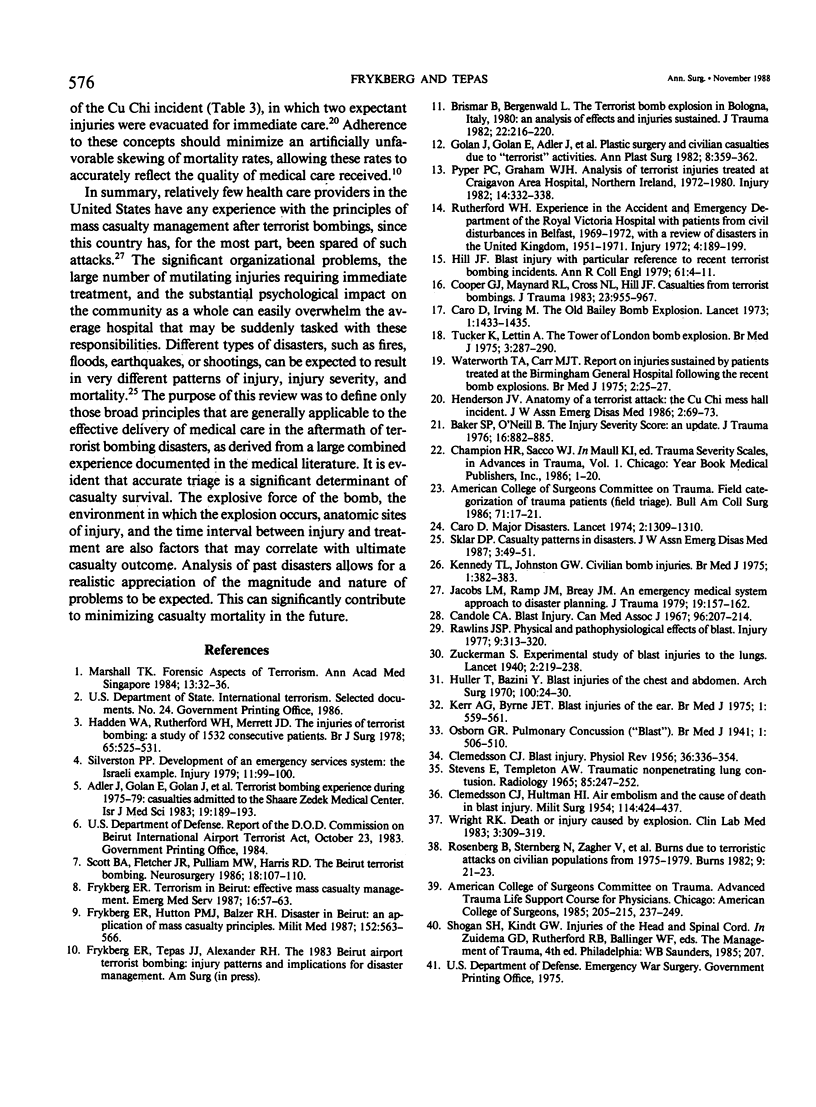
Images in this article
Selected References
These references are in PubMed. This may not be the complete list of references from this article.
- Adler J., Golan E., Golan J., Yitzhaki M., Ben-Hur N. Terrorist bombing experience during 1975-79. Casualties admitted to the Shaare Zedek Medical Center. Isr J Med Sci. 1983 Feb;19(2):189–193. [PubMed] [Google Scholar]
- Baker S. P., O'Neill B. The injury severity score: an update. J Trauma. 1976 Nov;16(11):882–885. doi: 10.1097/00005373-197611000-00006. [DOI] [PubMed] [Google Scholar]
- Brismar B., Bergenwald L. The terrorist bomb explosion in Bologna, Italy, 1980: an analysis of the effects and injuries sustained. J Trauma. 1982 Mar;22(3):216–220. doi: 10.1097/00005373-198203000-00007. [DOI] [PubMed] [Google Scholar]
- CLEMEDSON C. J. Blast injury. Physiol Rev. 1956 Jul;36(3):336–354. doi: 10.1152/physrev.1956.36.3.336. [DOI] [PubMed] [Google Scholar]
- CLEMEDSON C. J., HULTMAN H. I. Air embolism and the cause of death in blast injury. Mil Surg. 1954 Jun;114(6):424–437. [PubMed] [Google Scholar]
- Caro D., Irving M. The Old Bailey bomb explosion. Lancet. 1973 Jun 23;1(7817):1433–1435. doi: 10.1016/s0140-6736(73)91753-4. [DOI] [PubMed] [Google Scholar]
- Caro D. Major disasters. Lancet. 1974 Nov 30;2(7892):1309–1310. doi: 10.1016/s0140-6736(74)90160-3. [DOI] [PubMed] [Google Scholar]
- Cooper G. J., Maynard R. L., Cross N. L., Hill J. F. Casualties from terrorist bombings. J Trauma. 1983 Nov;23(11):955–967. doi: 10.1097/00005373-198311000-00001. [DOI] [PubMed] [Google Scholar]
- Frykberg E. R., Hutton P. M., Balzer R. H., Jr Disaster in Beirut: an application of mass casualty principles. Mil Med. 1987 Nov;152(11):563–566. [PubMed] [Google Scholar]
- Golan J., Golan E., Alder J., Sternberg N., Zagher U., Rosenberg B., Ben-Hur N. Plastic surgery and civilian casualties due to "terrorist" activities. Ann Plast Surg. 1982 May;8(5):359–362. doi: 10.1097/00000637-198205000-00001. [DOI] [PubMed] [Google Scholar]
- Hadden W. A., Rutherford W. H., Merrett J. D. The injuries of terrorist bombing: a study of 1532 consecutive patients. Br J Surg. 1978 Aug;65(8):525–531. doi: 10.1002/bjs.1800650802. [DOI] [PubMed] [Google Scholar]
- Hill J. F. Blast injury with particular reference to recent terrorist bombing incidents. Ann R Coll Surg Engl. 1979 Jan;61(1):4–11. [PMC free article] [PubMed] [Google Scholar]
- Huller T., Bazini Y. Blast injuries of the chest and abdomen. Arch Surg. 1970 Jan;100(1):24–30. doi: 10.1001/archsurg.1970.01340190026008. [DOI] [PubMed] [Google Scholar]
- Jacobs L. M., Jr, Ramp J. M., Breay J. M. An emergency medical system approach to disaster planning. J Trauma. 1979 Mar;19(3):157–162. doi: 10.1097/00005373-197903000-00005. [DOI] [PubMed] [Google Scholar]
- Kennedy T. L., Johnston G. W. Surgery of violence. 1. Civilian bomb injuries. Br Med J. 1975 Feb 15;1(5954):382–383. doi: 10.1136/bmj.1.5954.382. [DOI] [PMC free article] [PubMed] [Google Scholar]
- Kerr A. G., Byrne J. E. Surgery of violence. IV. Blast injuries of the ear. Br Med J. 1975 Mar 8;1(5957):559–561. doi: 10.1136/bmj.1.5957.559. [DOI] [PMC free article] [PubMed] [Google Scholar]
- Marshall T. K. Forensic aspects of terrorism. Ann Acad Med Singapore. 1984 Jan;13(1):32–36. [PubMed] [Google Scholar]
- Osborn G. R. Pulmonary Concussion ("Blast"). Br Med J. 1941 Apr 5;1(4187):506–510. doi: 10.1136/bmj.1.4187.506. [DOI] [PMC free article] [PubMed] [Google Scholar]
- Pyper P. C., Graham W. J. Analysis of terrorist injuries treated at Craigavon Area Hospital, Northern Ireland, 1972-1980. Injury. 1983 Jan;14(4):332–338. doi: 10.1016/0020-1383(83)90250-4. [DOI] [PubMed] [Google Scholar]
- Rawlins J. S. Physical and pathophysiological effects of blast. Injury. 1978 May;9(4):313–320. doi: 10.1016/s0020-1383(77)80053-3. [DOI] [PubMed] [Google Scholar]
- Rosenberg B., Sternberg N., Zagher U., Golan J., Golan E., Adler J., Ben-Hur N. Burns due to terroristic attacks on civilian populations from 1975 to 1979. Burns Incl Therm Inj. 1982 Sep;9(1):21–23. doi: 10.1016/0305-4179(82)90131-0. [DOI] [PubMed] [Google Scholar]
- Rutherford W. H. Experience in the accident and emergency department of the Royal Victoria Hospital with patients from civil disturbances in Belfast 1969-1972, with a review of disasters in the United Kingdom 1951-1971. Injury. 1973 Feb;4(3):189–199. doi: 10.1016/0020-1383(73)90038-7. [DOI] [PubMed] [Google Scholar]
- STEVENS E., TEMPLETON A. W. TRAUMATIC NONPENETRATING LUNG CONTUSION. Radiology. 1965 Aug;85:247–252. doi: 10.1148/85.2.247. [DOI] [PubMed] [Google Scholar]
- Scott B. A., Fletcher J. R., Pulliam M. W., Harris R. D. The Beirut terrorist bombing. Neurosurgery. 1986 Jan;18(1):107–110. doi: 10.1227/00006123-198601000-00020. [DOI] [PubMed] [Google Scholar]
- Silverston P. P. Development of an emergency services system--the Israeli example. Injury. 1979 Nov;11(2):99–100. doi: 10.1016/s0020-1383(79)80004-2. [DOI] [PubMed] [Google Scholar]
- Tucker K., Lettin A. The Tower of London bomb explosion. Br Med J. 1975 Aug 2;3(5978):287–290. doi: 10.1136/bmj.3.5978.287. [DOI] [PMC free article] [PubMed] [Google Scholar]
- Waterworth T. A., Carr M. J. Report on injuries sustained by patients treated at the Birmingham General Hospital following the recent bomb explosions. Br Med J. 1975 Apr 5;2(5961):25–27. doi: 10.1136/bmj.2.5961.25. [DOI] [PMC free article] [PubMed] [Google Scholar]
- Wright R. K. Death or injury caused by explosion. Clin Lab Med. 1983 Jun;3(2):309–319. [PubMed] [Google Scholar]
- de Candole C. A. Blast injury. Can Med Assoc J. 1967 Jan 28;96(4):207–214. [PMC free article] [PubMed] [Google Scholar]




